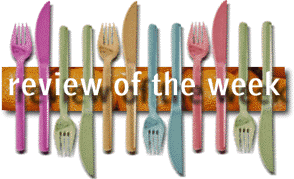
| Review of the Week | On the Cheap | Noshing and Sipping | Restaurant Guide | Hot Links |
Banana Leaf
25 Tyler Street, Boston (Chinatown); 422-0664Hours: Sun - Thurs, noon to 11 p.m.; Fri and Sat, noon to midnight
AE, DC, Di, MC, Vi
Beer and wine
Up eight steps from sidewalk level
by Robert Nadeau
For some reason, the Southern Chinese men who migrated to Malaysia as merchants, tin miners, and rubber workers in the mid-19th century did two things that few other overseas Chinese did -- they married local women, and they ate Chinese-influenced versions of local food. This didn't happen in California or Vietnam or the Philippines, but it happened with wonderful culinary results in Singapore, Penang, Malacca, and Colombo.
As well as I can read this long menu of unfamiliar dishes, I most highly recommend the straight Malay food at Banana Leaf, then the Chinese regional specialties of the groups that settled Malaysia (anything labeled Teow Chow, Hainanese, or Hokkien), then the dishes called "nyonya." Although I really recommend all of them, and suspect you would also be just fine with the "Indonesian fried chicken," the "Malay Cantonese vermicelli" or the "Thai-style char kway teow."
On two greedy visits, we could find few dull dishes at Banana Leaf, and many delights. Although many of the dishes are new, the menu has excellent explanations of several favorites, such as an appetizer/salad/side dish called achat ($2.75). This is shredded cabbage, carrots, and a few cucumber slices in a sweet-hot-sesame pickle with a sprinkling of chopped peanuts and sesame seeds. It's refreshing, appetizing, and addictive at the same time.
Bak kut teh is described on the menu as "herbal soup" ($4.50, $6.95, $11.25, depending on size). This implies greenery, but in fact the literal translation is "pork-bone soup," and it was mostly spare ribs and spare parts of pork, with the herbal medicine coming from healing doses of ginger and anise, and a whole head of simmered garlic -- the ideal prescription for our late-winter colds. Ipoh kway teow with fish balls ($4.50) wasn't at all fishy, and was full of green watercress, along with mild fish balls and wide chow foon noodles, in a slightly peppery stock. A familiar "superior wonton soup" ($3.50) was in fact based on the Chinese "superior stock" made with browned chicken and pork bones, here a background for meaty won tons and thin vermicelli.
Malaysian fried tofu ($4.75) may owe something to yet another Chinese group, the Hakka, who were later settlers and specialize in stuffed tofu dishes of this kind. The tofu is stuffed with a minced-shrimp filling, but the brilliance is in the frying, which gives it a crust outside while developing an ambrosial curdy texture inside. If the tofu boats stuffed with shrimp on a little salad begin to seem dull, this is a good moment to introduce a remarkable hot sauce, which comes in a small dish, that I believe is called "belachan": a medium chili purée with a few seeds, freshened with lime juice and lent complexity by shrimp paste.
Malaysian spare ribs ($7.95) are also fried, in a very slight batter. Their mellowness makes me suspect they may be marinated as well. Malaysian sausage fried rice ($4.50) is halfway between a yang chow fried rice -- white with bits of vegetables -- and the old Cantonese-American fried rice with a lot of egg and soy sauce. This has a little soy sauce, but not enough to obscure the bits of intriguingly sweet-spiced sausage. The same idea with slightly larger slices of sausage ends up in char kway teow ($5.25), the Singaporean answer to chow foon or pad thai.
An appetizer of calamari with watercress ($7.25) has a couple of wonderful surprises. The first is the pieces of squid, which are somehow manipulated to a crunchy, but not chewy, texture -- more like carrots or celery than seafood. The second surprise is a drizzle of hoisin sauce that pulls the watercress and the unusual calamari together into a really appetizing salad.
Sambal ikan bilis ($5.95) tames another challenging seafood into a splendid appetizer. The flavoring is fillets of fresh anchovies, fried till crisp and played for sweetness in a hot salad-stew with tomatoes and onions.
Not every novelty at Banana Leaf requires courage. "Banana Leaf oat prawn" ($9.95) is a nice dish of fried shrimp in some starchy coating that caramelizes to a rich, chocolaty aroma. The staff describes this as oatmeal, but I suspect that taro root may be involved.
My favorite dish is the Banana Leaf asam stingray ($9.25). In Asia, this particular curry is applied to stingray, but here the seafood of choice is the underrated New England skate -- one of the most delectable morsels in the local ocean. Skate is mild in flavor, but with enough character to be noticed under a beautifully made red curry sauce. "Asam" means tamarind in several languages of South Asia, and there is a tart, tamarind note here, but the noticeable flavors in this complex sauce are ginger, lemongrass, onion, and the sprinkling of cilantro on top.
More routine stir-fries weren't my favorite dishes at Banana Leaf, although they had their moments. On one visit a waiter recommended the spicy chicken with lemongrass ($7.50), which is a nice enough way to sample the unusual herb, but otherwise a rote sweet-and-sour stir-fry with onions and bell peppers. Likewise "nyonya style (stirfry squid)" ($8.75), for which I had high hopes, was peppery but otherwise unexciting.
Atmosphere is set by some Malaysian folk art on the walls, and two rooms full of very excited diners, so far mostly Asian-American. I found the staff eager to help and make recommendations, and quite tactful about the growing problem of people waiting for one's table. There are no listed desserts, but big eaters who show some appreciation for the cuisine may be offered something like a hot bowl of sweetened coconut milk with black beans -- truly comfort food.
